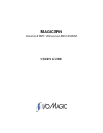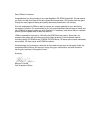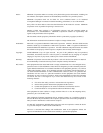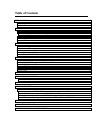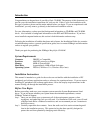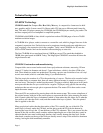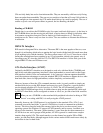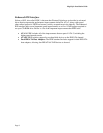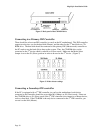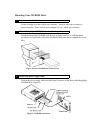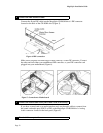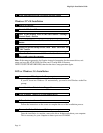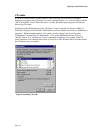
CDs are fairly hardy but are far from indestructible. They are reasonably solid but overly flexing
them can make them unreadable. They are not too sensitive to heat but will warp if left to bake in
direct sunlight on a hot summer's day. CD media should always be cared for properly. The use of
caddies or jewel cases will protect them; in general, the less handling, the better.
Reading a CD-ROM
Digital data is carved into the CD-ROM as pits (low spots) and lands (high spots). As the laser in
the CD-ROM shines into the moving pits and lands, a sensor detects a change in reflection when
it encounters a transition from pit to land or land to pit. Each transition is a 1. The lack of
transitions are 0s. There is only one laser in a drive. Two are used here to illustrate the difference
in reflection.
IDE/ATA Interface
IDE stands for Integrated Drive electronics. The name IDE is the more popular of the two, even
though it is misleading which refers to putting the logic board with the hard disk much more than
it has anything to do with the interface. The more correct name is ATA or AT Attachment, which
defines the standard interface as attached to an AT-style machine (which is the generic way of
describing every PC since the old 8-bit XT). The IDE/ATA interface is 16 bits wide, just as the
original IBM AT's data and I/O buses were.
ATA Packet Interface (ATAPI)
Originally, the IDE/ATA interface was designed to work only with hard disks. CD-ROMs and
tape drives used either proprietary interfaces (often implemented on sound cards) or the floppy
disk interface (which is slow and cumbersome). A few years ago it became apparent that there
would be enormous advantages to using the standard IDE/ATA interface to support devices other
than hard disks, due to its high performance, relative simplicity, and universality.
However, because of how the ATA command structure works, it wasn't possible to simply put
non-hard-disk devices on the IDE channel and expect it to work. Therefore, a special protocol
was developed called the ATA Packet Interface or ATAPI. The ATAPI standard is used for
devices like CD-ROM and tape drives. It enables them to plug into the standard IDE cable used
by IDE/ATA hard disks, and be configured as master or slave, etc. just like a hard disk would be.
Note:
When you see a CD-ROM or other non-hard-disk peripheral advertised as being an "IDE
device" or working with IDE, it is really using the ATAPI protocol.
Internally, however, the ATAPI protocol is not identical to the standard ATA (ATA-2, etc.)
command set used by hard disks. A special ATAPI driver is used to communicate with these
devices. This driver must be loaded into memory before the device can be accessed (some
operating systems like Windows 95 support ATAPI internally and in essence, load their own
drivers for the interface). The name "packet interface" comes from the fact that commands to
ATAPI devices are sent in groups called packets; ATAPI in general is a much more complex
interface than regular ATA. The actual transfers over the channel use regular PIO or DMA
modes, just like hard disks, although support for the various modes differs much more widely by
device than it does for hard disks.



